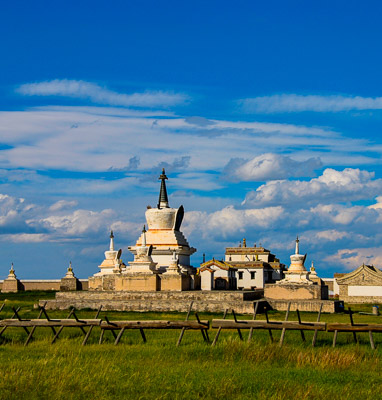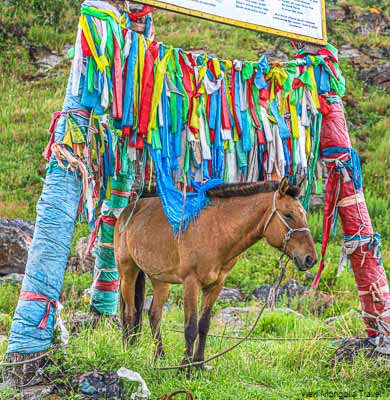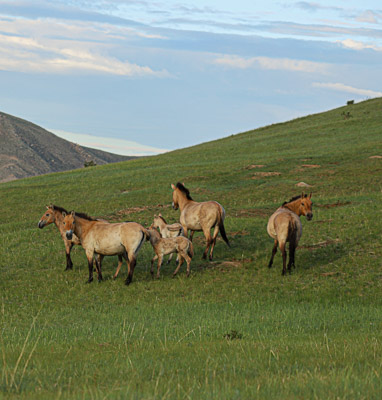Erdenezuu Monastery
LOCATION: Connected by an asphalt road, 360 km southwest of Ulaanbaatar, on the east bank of the Orkhon River in Kharkhorin soum, Uvurkhangai province is a part of the Orkhon Valley Cultural Landscape World Heritage Site by UNESCO.
Entrance to the monastery ground is free, although you should get a ticket if you visit the museum temples.
Summer timetable: 09:00 to 18:00 daily between 1 May and 30 September
Winter timetable: 09:00 to 17:00 on weekdays between 1 October and 31 April
Erdenezuu Monastery was built on the site of the old Mongolian capital Kharakhorum using some of the building materials of the ruined city and is the oldest, as well as the largest Buddhist monastery in Mongolia.
Khalkha Mongolian ruler Abtai Sain Khan, a descendant of Genghis Khan’s golden generation and grandfather of Zanabazar - the first Jebtsundamba Khutuktu, ordered the construction of the Erdenezuu Monastery in 1585 after he visited Tibet to meet with the 3rd Dalai Lama. Abtai Sain Khan brought Gombogur Buddha ( Sita Mahakala) as the main deity of Erdenezuu Monastery when he returned from Tibet and is still the monastery’s main shrine.
By the summer of 1586, the first temple had been constructed, which is a small blue temple in the middle of the monastery compound, but not open to the public.
400m by 400 m fortress wall surround the monastery - the wall bears evenly spaced white stupas, 25 on each side, and two additional ones at each corner for a total of 108, although several are currently damaged or missing. 108 is a sacred Buddhist number.
The surrounding stupas were built after 200 years of the monastery's foundation by the fund of alm givers and worshippers of Buddha. Each wall has a huge gate at the midpoint.
At its peak, the monastery had 62 temples, around 500 gers inside the walls, and 1000 monks in residence.
The monastery was ransacked and damaged several times. Galdan, the ruler of Oirat Mongol ransacked Erdenezuu Monastery in 1688 when he was invading after Zanabazar, a religious leader of the time, and devastated again by Galdan’s nephew Tserenin 1732. Although, the monastery was both abandoned and refurbished in between.
Later, the monastery was partially destroyed by the communists in 1937. The government protected the monastery between 1940 and 1965, then transformed into a museum in 1965 with no monks in residence. The religious activities again began in 1990 after the collapse of communism. In 1997, the government decided to restore the monastery, although most of it functions as a museum.
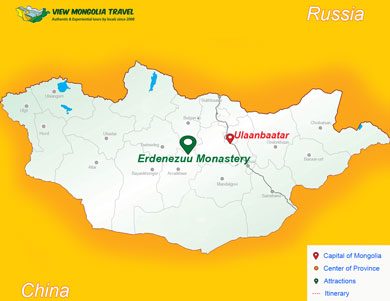
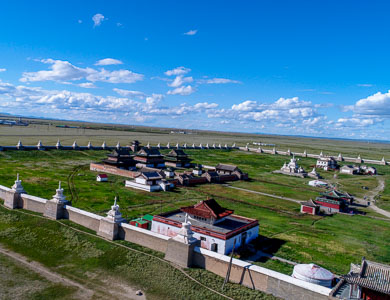
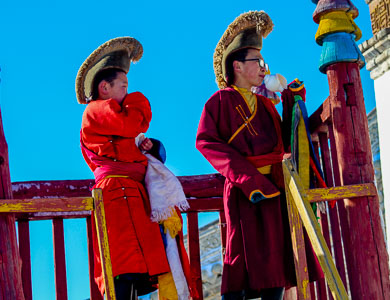
Erdenezuu Monastery houses some of the most precious of Mongolia’s artifacts of 16th to 19th-century Buddhist masters, comprising of 3 large temples, one Tibetian style active temple, a big ger temple, stupas, the surrounding wall, some other small temples, and buildings.
The museum part consists of Three Zuu Temple (West Zuu Temple, Middle Zuu Temple, and East Zuu Temple) that are in a separate courtyard surrounded by a double brick wall. The double-wall is first to protect the monastery from the heat and second, for praying called “Goroo murgul”.
The Three Zuu temples were praying temples than the chanting and flanked by Ayush and Tsamba temples in the same courtyard.
In front of the Three Zuu Temples are tombs of Abtai Sain Khan (1554-1588) and his grandson Tusheet Khan Gombodorj, father of Zanabazar.
West Zuu Temple: The first of the Three Zuu Temples, the so-called western temple, was built under the auspices of Avtai Sain Khan. There are three large deities of Buddhas on three altars. On the central altar is Buddha Shakyamuni (historic Buddha), to the west is Sanjaa (Buddha of Past), and to the east is Maitreya (Buddha of Future). There is a painting of Bogd Tsongkhapa, a founder of the Yellow Hat sect with his followers on the west wall and the east wall painting shows Buddha Shakyamuni with his disciples. The ceiling has decorated with paintings of Ayush Buddha (Buddha of Longevity) and Green Tara (relieve suffering and negativity)
On the table is a golden wheel of eternity, eight auspicious symbols – an umbrella, fish, vase, flower, cards, lucky diagram, victorious banner and wheel.
Middle Zuu Temple/Main Zuu Temple: Two protective Buddhas flank its door: Gombogur ( Sita Mahakala) –the main shrine of the whole monastery and Baldan Lkham (Sridevi), a female Buddha, also the strongest of the 10 protective Mahakalas. In the middle altar is the childhood figure of Buddha Shakyamuni, Amida Buddha (Amitabha- Buddha of Infinite Light) to his right and Otoch Manala (Buddha of Medicine) to his left. The temple also houses statues of the sun and the moon gods, eight auspicious symbols, seven jewels of the state, coral Mandala, and Tsam religious dance mask dating from the 16th-17th centuries.
East Zuu Temple: Central statue is of the adolescent Buddha. To his left is a statue of Bogd Tsongkhapa (Yellow Hat sect founder) while on his right is a statue of Janraisag (Buddha of Compassion). The wall paintings depict 35 Dunshig Buddha (35 protective Buddhas of the heaven) and reincarnations of Bogd Tsongkhapa.
Both Ayush and Tsamba Temples in the Three Zuu Temple courtyard have 3 rooms where 4 monks used to chant in each room, now houses invaluable arts of the 17th and 18th centuries such as appliques, tankas, and wall paintings.
Dalai Lama Temple near the main gate was built in 1675 to commemorate the visit of Abtai Sain Khan’s son Altan to Tibet to pay his respect to the Dalai Lama. This red-brick and gold temple is a part of the museum, which contains a statue of Zanabazar, ritual items, some tankas, and figures of protective deities. Two small prayer temples exist on the two sides of the Dalai Lama Temple.
There is a Bodhi Stupa/Large Stupa near the small old temple in the middle of the Erdenezuu compound. This large golden topped stupa is surrounded by 8 smaller stupas, was built by 4th Bogd Gegeen in 1799. It reportedly houses 155000 religious books, 70 small stupas, 2500 pyramids, 100000 Buddha figures, and numerous ritual items.
Further to the east is a tree-story Tibetan style Lavrin Temple, which was built in 1875 and is a remodeling of the earlier version. This is a functioning temple where the monks function daily religious ceremonies.
Additionally, there is an active big ger temple near the golden stupa.
